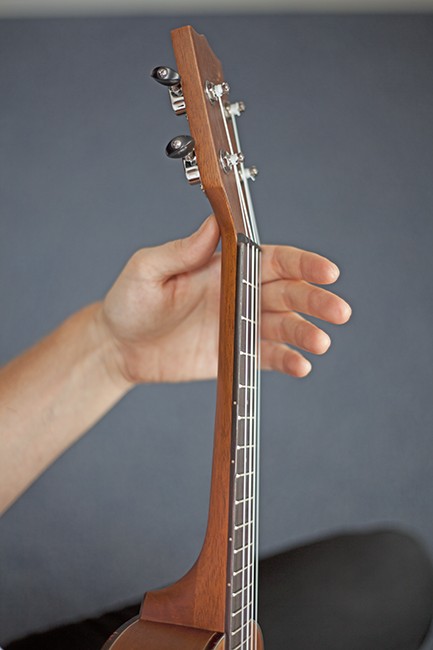Ukulele For Dummies (11 page)
Read Ukulele For Dummies Online
Authors: Alistair Wood

Figure 3-5:
Fretting hand, initial position.

Curl your fingers around so that they arc high over the strings, just like in Figure 3-6. You need to make sure that your finger doesn't touch any string other than the one you want to fret.
Figure 3-6:
Fretting hand, final position.

 When you're playing a particularly tricky passage, you can move your thumb to the back of the neck, which frees up your fingers and lets you apply more pressure.
When you're playing a particularly tricky passage, you can move your thumb to the back of the neck, which frees up your fingers and lets you apply more pressure.
 The frets on the ukulele are counted from the headstock end, and so the first fret wire that you come across is called the first fret and the second is the second fret. I can tell you're smart, and so I assume that you've spotted the pattern here.
The frets on the ukulele are counted from the headstock end, and so the first fret wire that you come across is called the first fret and the second is the second fret. I can tell you're smart, and so I assume that you've spotted the pattern here.
Locating where to fret
Place your finger just behind the fret, not on top of it. So, for example, to play the second fret you press the string down between the first and second fret wires.
 The fret wire does the job of stopping the string, not your finger.
The fret wire does the job of stopping the string, not your finger.
Discovering how strongly to fret
Apply just enough pressure to the strings so that they ring clearly. If you press down too hard, you tire out your hand and bend the string out of tune.
Start out by just resting your finger against the string. Don't press it down at all. Pluck the string with your thumb and you just hear a click.
Keep plucking the string and slowly increase the amount of pressure you're placing on the string with your fretting finger: you start to hear the note get clearer.
When you can hear the note clearly, stop. This pressure is how hard you press down the string.
Adjusting when things don't sound right
You're going to need to practise a little before you can fret cleanly. You may hear the string buzzing or just get a dead âthunk'. Don't worry.
If you find that you're having a fretting problem, come back to this section and run through the following checklist:
 Is your finger touching the fret wire?
Is your finger touching the fret wire?
If so, move it back a little.
 Are you pressing down hard enough?
Are you pressing down hard enough?
Gently increase the pressure on the string and see whether that improves the situation.
 Is another finger touching the string?
Is another finger touching the string?
Check that the string is clear of anything touching it other than your fretting finger.
If you still get buzzing sounds no matter what you try, you may have a problem with the ukulele itself, particularly if the problem occurs only on a certain string or at a certain fret. Chapter 19 contains advice on several repairs that may solve the problem.
Playing and pain
Most people don't spend much of their day-to-day life pushing wire into wood with their fingers, and so your hands are going to take some time to get used to doing so. During that time, you're likely to encounter some pain.
Watch out for the following types of pain:
 Muscle pain:
Muscle pain:
Your hands and fingers get sore from pressing down the strings.
 Fingertip pain:
Fingertip pain:
The tips of your fingers become sore or wear away from contact with the strings.
Rest your hand when you start feeling muscle pain, because gritting your teeth and carrying on is pointless. Doing so is likely to cause permanent damage. Instead, gradually increase your practice time as your hand gets stronger.
Fingertip pain isn't so dangerous: it hurts but you're not going to get permanently injured. Simply rest when you have to. Eventually your fingertips develop calluses and after they're in place, you don't feel a thing. Anyway, you then have a good party trick when you can stab your fingertips with a pin and show no pain.
Part II
Starting Out With Chords and Strumming

In this part . . .
You discover the nuts and bolts of ukulele playing: basic chords; complex chords; and plenty of strumming patterns and rhythms. And each chapter contains loads of songs for you to try out your brand new skills.
